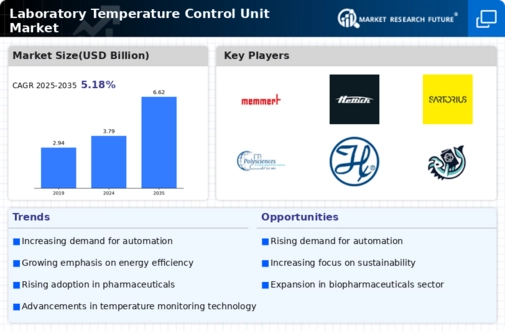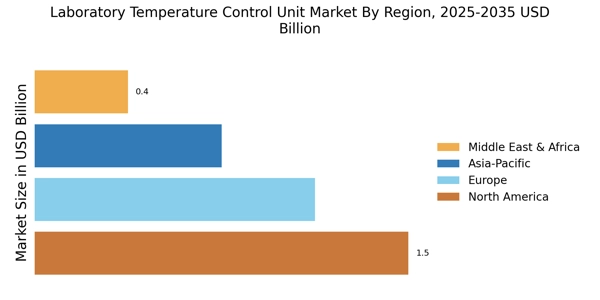Increased Focus on Quality Control
Quality control remains a critical aspect of laboratory operations, and the Laboratory Temperature Control Unit Market is responding to this need. Laboratories are increasingly implementing stringent quality assurance protocols to ensure that their results meet regulatory standards. Temperature control units play a vital role in this process, as they help maintain the required conditions for experiments and storage. The rise in quality control measures is reflected in the growing investments in laboratory infrastructure, with a projected increase of 4% in laboratory spending over the next few years. This trend underscores the importance of reliable temperature control systems in achieving compliance with industry standards and enhancing overall laboratory performance.
Expansion of Biopharmaceutical Sector
The Laboratory Temperature Control Unit Market is significantly influenced by the expansion of the biopharmaceutical sector. As biopharmaceutical companies ramp up their research and development activities, the demand for sophisticated temperature control solutions is likely to rise. These units are essential for maintaining the integrity of sensitive biological materials, such as vaccines and cell cultures, which require precise temperature regulation. The biopharmaceutical market has been projected to reach a valuation of over 500 billion by 2025, indicating a robust growth trajectory. This expansion necessitates advanced laboratory temperature control units to support the increasing volume of research and production activities, thereby driving market growth.
Rising Demand for Precision in Research
The Laboratory Temperature Control Unit Market is experiencing a notable increase in demand for precision in research and experimentation. As laboratories strive for accuracy in their results, the need for reliable temperature control units becomes paramount. This trend is particularly evident in sectors such as pharmaceuticals and biotechnology, where even minor temperature fluctuations can lead to significant variations in experimental outcomes. According to recent data, the market for laboratory temperature control units is projected to grow at a compound annual growth rate of approximately 6.5% over the next five years. This growth is driven by the increasing complexity of research protocols and the necessity for stringent temperature management to ensure reproducibility and reliability in scientific studies.
Growing Investment in Research and Development
The Laboratory Temperature Control Unit Market is benefiting from the growing investment in research and development across various sectors. Governments and private entities are allocating substantial funds to enhance research capabilities, particularly in fields such as healthcare, environmental science, and materials science. This influx of investment is likely to drive the demand for laboratory temperature control units, as researchers require reliable equipment to maintain optimal conditions for their experiments. Recent reports indicate that R&D spending is expected to increase by approximately 5% annually, further fueling the need for advanced temperature control solutions. This trend highlights the critical role that temperature control units play in supporting innovative research initiatives.
Technological Innovations in Temperature Control
Technological innovations are reshaping the Laboratory Temperature Control Unit Market, leading to the development of more efficient and user-friendly systems. Advances in digital technology, such as IoT integration and smart monitoring systems, are enhancing the capabilities of temperature control units. These innovations allow for real-time monitoring and adjustments, which can significantly improve the accuracy and reliability of temperature management in laboratories. As laboratories increasingly adopt these advanced technologies, the market for temperature control units is expected to witness substantial growth. The integration of smart technologies is projected to account for a significant share of the market, reflecting a shift towards more automated and efficient laboratory environments.


















Leave a Comment